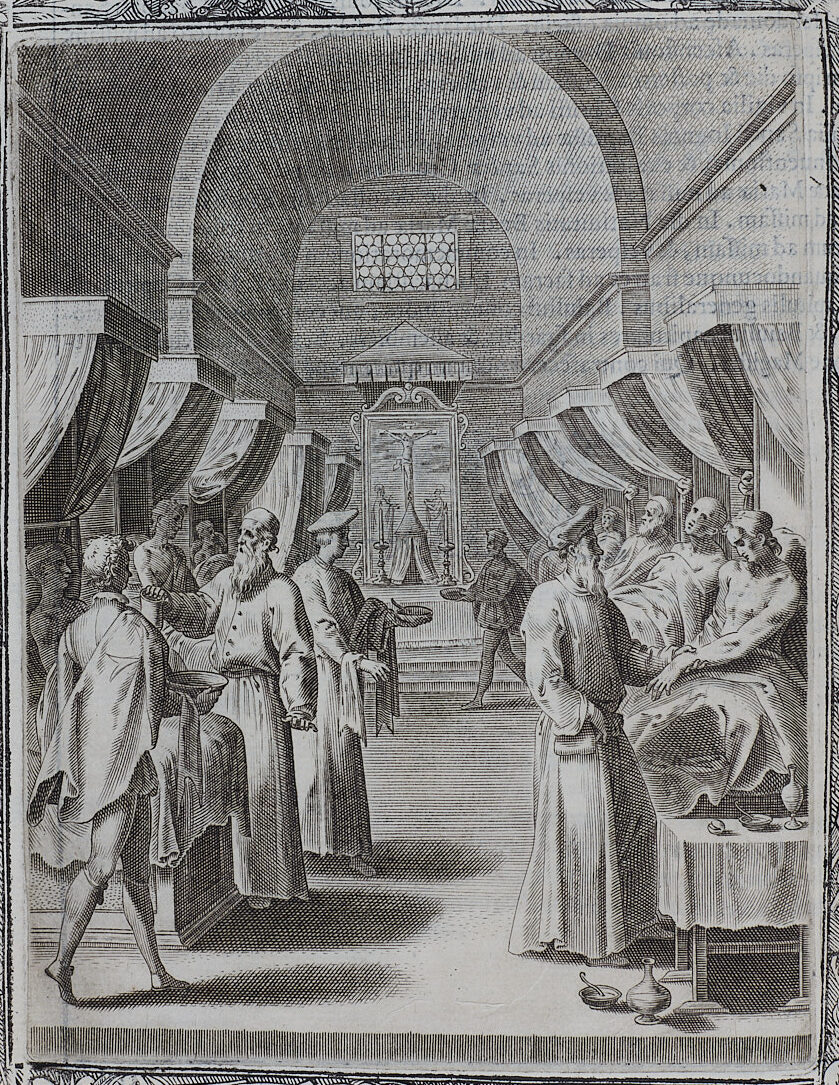
History Day 2022
Human Discovery: Experiencing Science
Lambeth Palace Library is the historic library of the Archbishops of Canterbury and it preserves the National Archives of the Church of England. In addition to materials specific to the Church, the Library holds a range of archival and printed sources on other subjects. The works below have been selected as highlighting the impact of science and technology, particularly in the field of medicine, on the lives of ordinary people.
Medieval & Early Modern Medicine
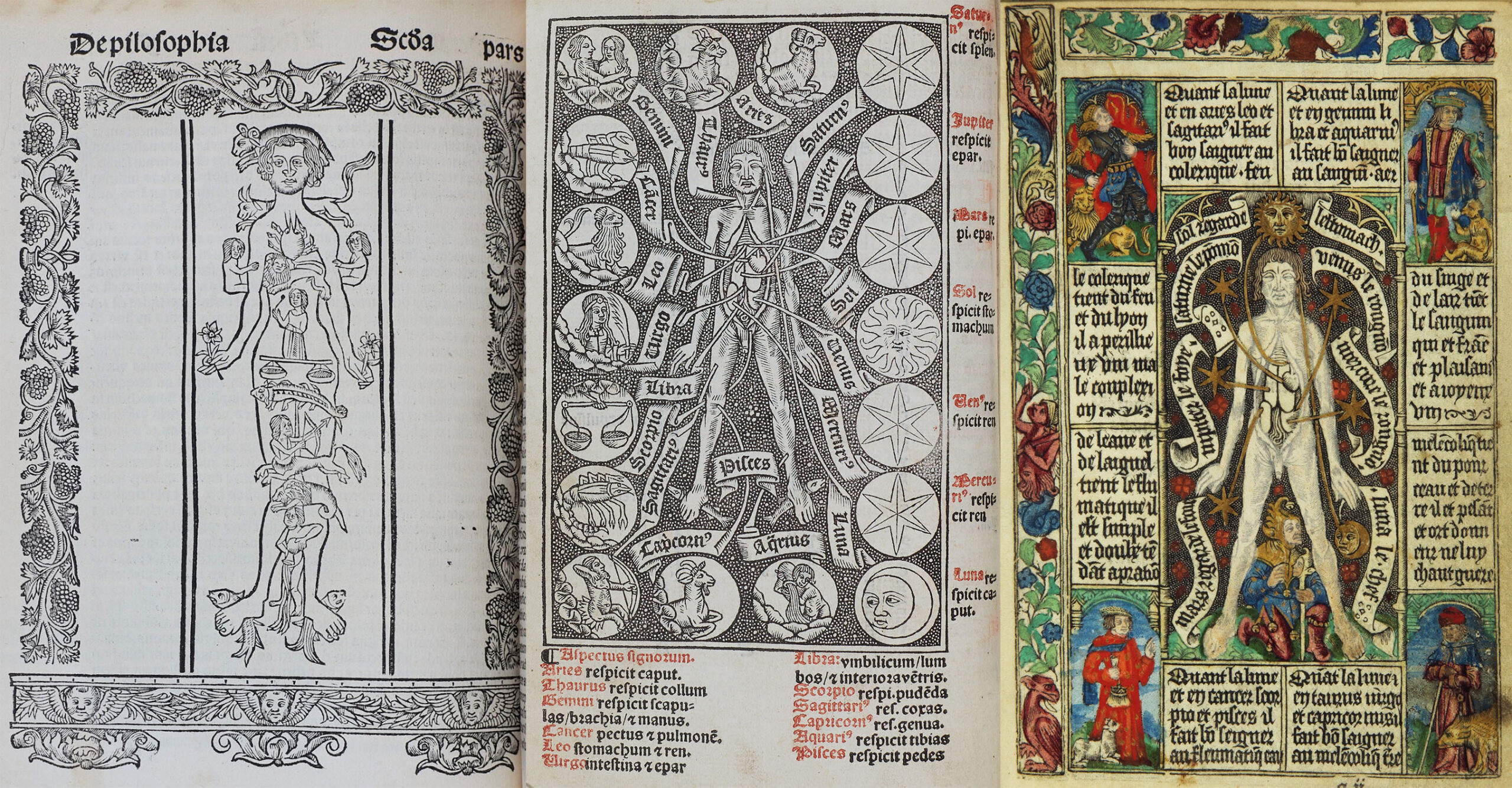
In the medieval era, it was often believed that God was responsible for illnesses and diseases. The practice of medicine, as endorsed by the Church, was informed by the works of ancient Greek and Roman physicians. Hippocrates (460-370 BCE) described the human body as made up of four fluids or “humours”; blood, phlegm, yellow bile and black bile.
Based on Hippocrates’ humoral theory, Galen (129-c.216 CE) suggested that an imbalance in these humours, or dyscrasia, was the cause of all diseases. Any ailments or health issues could be restored by balancing the humours often regulated by examining urine and phlebotomy. Galen argues that humoural imbalances could be attached to specific organs. Galen based his medical investigations on experimental methods. He proved that urine formed in the kidney. Lambeth Palace Library holds the eight volumes of Galeni Opera published in 1542 [I577.G2].
Humoral theory influenced the practice of medicine throughout the Middle Ages into the Early Modern period.
From 1200 to 1500 medical knowledge was guided by religion and astrology. It was largely confined to monasteries and the highly educated. Physicians and Barber-Surgeons made use of volvelles that helped to predict appropriate times to administer medical treatments based on the motion of the planets and phases of the moon.
Volvelle comes from the Latin word volvere (meaning ‘to turn’). Separate disks were sewn to the page in such a way that they could rotate about a central point.
As the top disk is turned, the circular window reveals the waxing and waning of a shining, golden Moon. Its shape changes according to the relative positions of the Sun and Moon, which are indicated by the two pointers, each marked by cheerful faces.
The Zodiac Man, Homo Signorum or ‘Man of Signs’, often appears in almanacs or calendars and treaties on astrology and medicine in the medieval era. In conjunction with astronomical carts and volvelles, the Zodiac Man was used to determine the correct time and anatomical location for surgery, bloodletting and any other administration of medication.

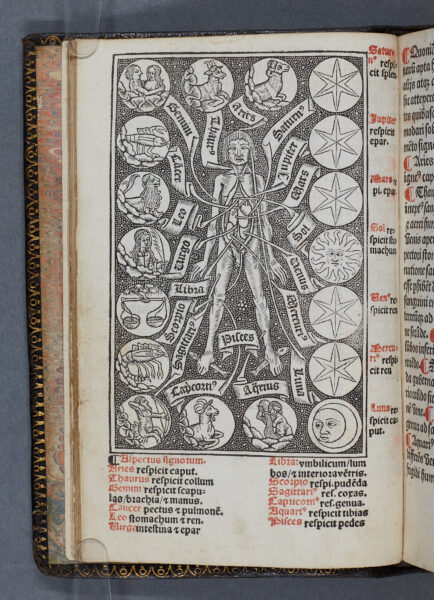
The Shepherds’ Kalendar was a compendium of popular lore on astronomy and its influences on the calendar, the seasons, and the human body. First issued in French, English translations were published from 1506. The Kalendar contains illustrations of the skeleton and the location of veins. It gives advice on appropriate times for bloodletting and which vein to choose to treat the ailment.
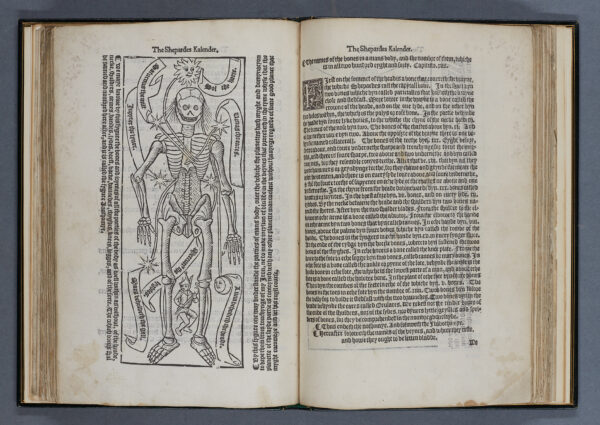
With the invention of the printing press the distribution of medical literature increased. Illustrated medical texts could now be reproduced and translated at a greater speed that extended the breath of medical knowledge throughout Europe.
The Church continued to play an important role for patient care from the Middle Ages through to the Early Modern period. Providing hospital care was part of the religious doctrine.
This elaborate and lavishly illustrated statues of the Knights Hospitallers of the Order of St. John of Jerusalem offers a glimpse into a 16th century hospital ward with physicians and nursing attendants. This hospital was at Valletta in Malta.
Lambeth Palace Library’s copy was owned by Archbishop John Whitgift (1530-1604).
It was often monasteries, some serving as infirmaries, that grew the supply of plants and herbs used for medicinal purposes.
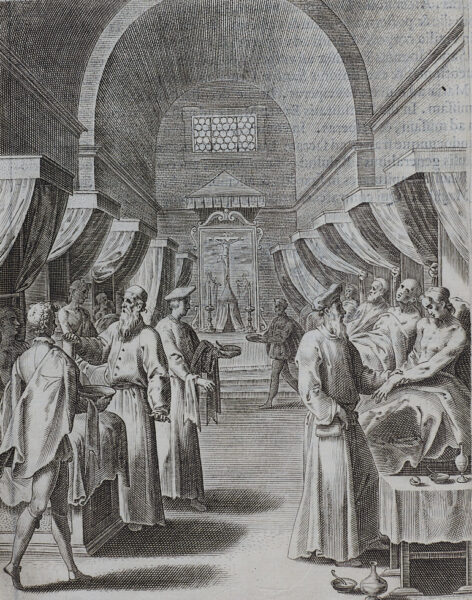

In the 16th century John Gerard (1545-1612), a Barber-Surgeon, authored the most elaborate herbal produced in England. Based on a translation of Flemish botanist Rembert Dodoens’ text Gerard’s The Herball or Generall Historie of Plants was first issued in 1597. It was subsequently enlarged and amended by the apothecary Thomas Johnson.
As shown below, each herb, tree and plant is accompanied with botanical studies of species varieties.
The engravings illustrate a detailed analysis of the plant and lists its virtues. For example Mercurie “is thought very good to clense and scoure away the excess and other filth contained in the gut.” Mercurie can be ‘juiced’ with Hollyhocks to sooth burning sensations and help with skin boils.
The herbal ends with a very useful and detailed list of ailments and herbals used to cure them.
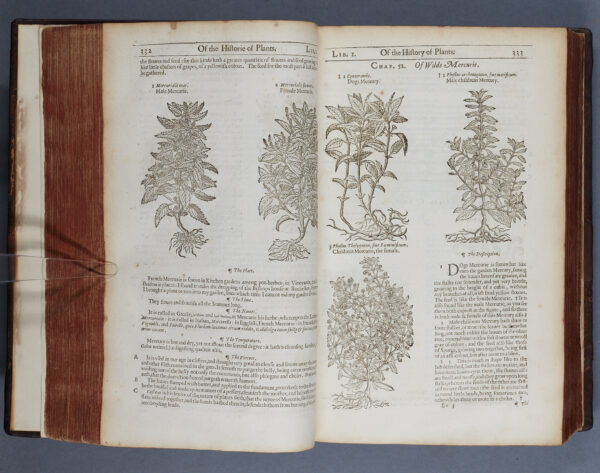
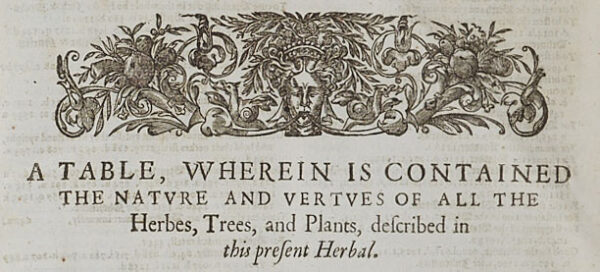
The Margarita Philosophica, first published in 1503 continues the tradition of the medieval encyclopedias in the field of natural and moral philosophy. Gregorius Reisch compiled into one volume the subjects considered mandatory for the educated western European of the 16th Century. It was adopted as a university textbook and covers 12 subjects: Latin grammar, dialectics, rhetoric, arithmetic, music, geometry, astronomy, physics, natural history, physiology, psychology and ethics.
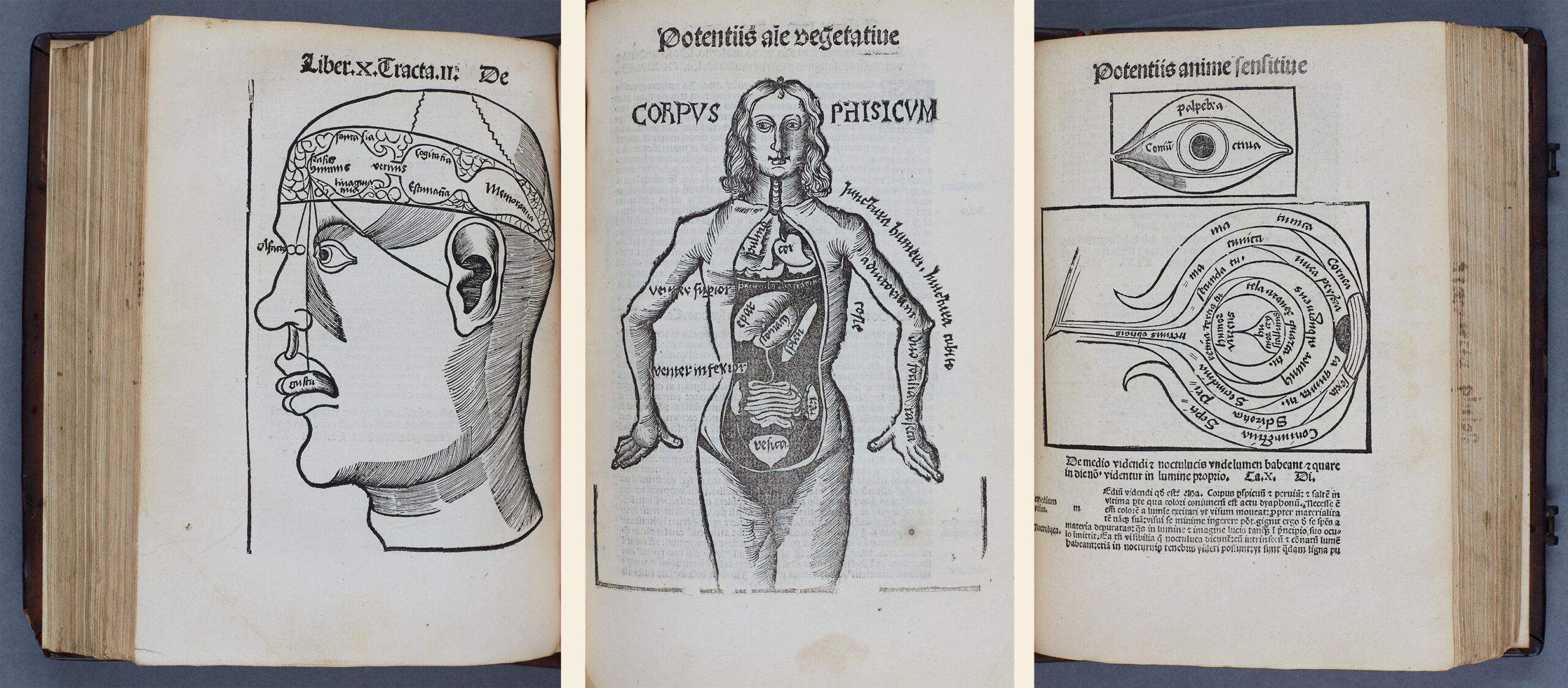
In the 16th Century it was believed that mental faculties were located in 3 distinct ventricles in the brain. The first held the information gathered from the senses illustrated in Figure 1. Lines led up from the lips, eyes and ears to the first ventricle where sensory information is stored. Information was then processed, via the vermis, to the central ventricle for cogitation. Thoughts then settled in the third ventricle and kept in memory.
The Margarita Philosophica contains what is probably the first diagram of the human eye to appear in print. Shown in Figure 3 from the front and as a sectioned profile. Here one can identify the detailed identification of eyelids, the pupils, the iris, the retina and the optic nerve.
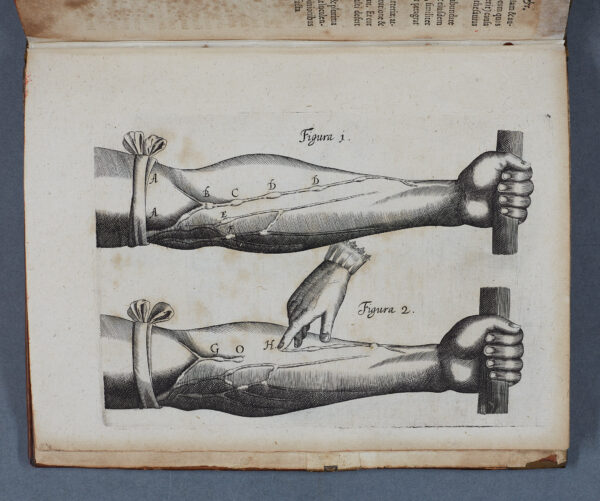
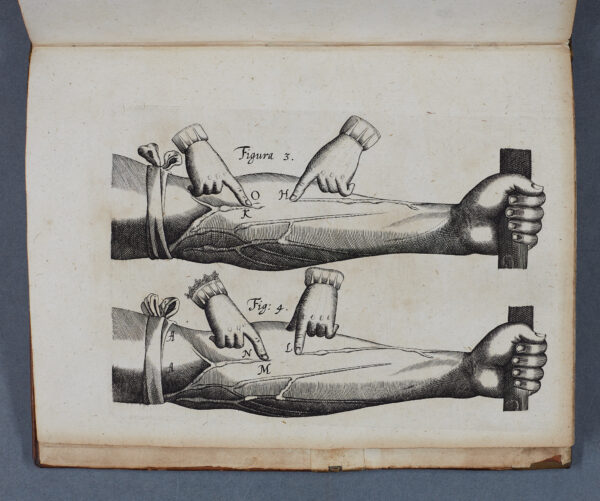
Exercitatio anatomica de motu cordis et sanguinis in animalibus (‘An Anatomical Exercise on the Motion of the Heart and Blood in Living Beings’) illustrates William Harvey’s physiological study of the circulatory system of blood throughout the body.
In his essay, Harvey describes the two phases of the cardiac cycle: the systole (contraction) and the diastole (expansion). By investigating the effect of ligatures on blood flow, Harvey made a substantial contribution to the study of cardiac physiology in the 17th Century. Figure 2 shows that blood only moves along the veins in one direction, while Harvey’s final experiment in Figures 3 & 4 shows that blood in the veins flows towards the heart.
This rare first edition belonged to Archbishop Abbot.
“It must of necessity be concluded that the blood is driven into a round by a circular motion in living creatures, and that it moves perpetually; and that this is the function of the heart, which by pulsation it performs“
De motu cordis, William Harvey, Francofurti, 1628 [**VP101.H2], Extract from Chapter XIV
Medical Licences
According to the Henrician statute of 1511, no physician or surgeon was to practise without first being examined by appropriate practitioners and licensed by the diocesan bishop. This system of episcopal or archiepiscopal control flourished for well over two centuries, but declined as the eighteenth century progressed.
The Archbishop granted licences throughout the province of Canterbury, an area which comprised England south of the Humber, and the whole of Wales. These Provincial licences issued principally by the Archbishop’s Vicar General, might be specific to a single locality or diocese, a number of dioceses, or more often, for the whole of the province of Canterbury. From 1576 until the Restoration, the principal source for information on these provincial licences is to be found in the Archbishops’ Registers.
For more detailed information please make use of the Library Research Guide on Medical licences.

